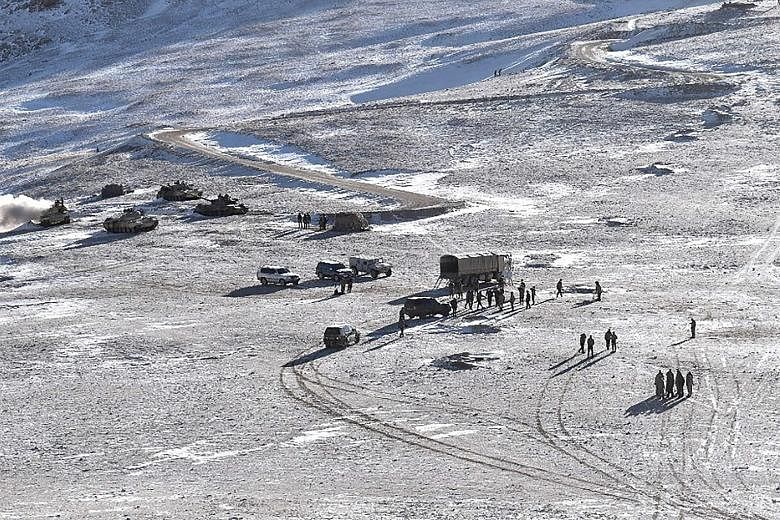NEW DELHI/BEIJING • After the deadliest fighting in decades, India and China are setting up demilitarised areas along their Himalayan border - a move that has rankled some members of India's security establishment.
Soldiers from both sides for now will no longer patrol a 9km stretch on the north bank of Pangong Tso, a glacial lake where troops clashed last year, according to two Indian officials aware of the developments.
The agreement would result in India pulling back from strategic high ground occupied in a stealth operation last August, they said.
The move followed the creation of a similar demilitarised zone last year some 150km away along the Galwan river, where 20 Indian soldiers and at least four Chinese troops were killed in hand-to-hand combat on June 15, the first time casualties were reported along the disputed frontier since 1975. China acknowledged the deaths only on Feb 19.
While the pullback has calmed tensions for now, some members of India's security establishment believe the creation of non-militarised areas works in Beijing's favour, according to the officials, who asked not to be identified.
They said China raised suspicions by objecting to an Indian proposal for both countries to patrol the area around the lake on alternate days on the grounds that it would affect Beijing's sovereignty.
Indian officials had raised their concerns about the area around Pangong Tso with the government but it opted for a speedy disengagement. On Feb 10, the two countries began rolling back soldiers, tanks and artillery guns stationed around the lake in rifle range of each other for nearly 10 months.
India's army, Defence Ministry and the Prime Minister's Office did not immediately reply to requests for comment.
China's Foreign Ministry said the creation of non-militarised zones along the border was "made up by the media". Last Friday in Beijing, Foreign Ministry spokesman Wang Wenbin said the situation on the ground significantly eased after the disengagement.
"The two sides should cherish this hard-won momentum and consolidate existing outcomes, maintain momentum for consultation and further ease the situation," he said at a regular media briefing.
Distrust between the two militaries could lead to further misunderstandings, said senior fellow at the New Delhi-based Centre for Policy Research Sushant Singh.
He said: "The model of buffer zones is temporary and full of challenges. More importantly, India's options are limited in case China... violates the agreement."
If the demilitarised areas end up keeping the peace, they could become a model for how India and China deal with border tensions.
Nationalism stoked by the fighting has had an economic impact, with Prime Minister Narendra Modi's government banning hundreds of Chinese apps, slowing approvals for Chinese investment and boosting security ties with the United States, Japan and Australia.
Still, while the demilitarised zones are aimed at preventing clashes of the sort that erupted last summer, the competing claims between the two sides remain, officials said. A previous experiment to create a demilitarised zone on the border with China has shown that it was not a guarantee of peace.
An 80 sq km patch of pasture land along the southern edge of the Tibetan Plateau and the Indian border state of Uttarakhand was the first to be set aside as no-man's-land in the 1950s.
Yet that has failed to prevent conflict in the area, according to Mr Jayadeva Ranade, a member of India's National Security Council Advisory Board. "Uttarakhand border continues to be a hot spot," he said. "Beijing's track record of respecting agreements is poor."
BLOOMBERG
SEE EDITORIAL • Positive momentum in China-India ties

